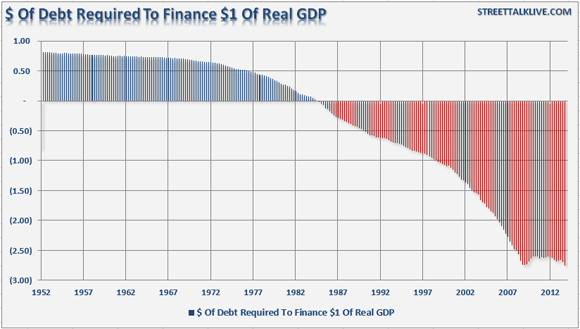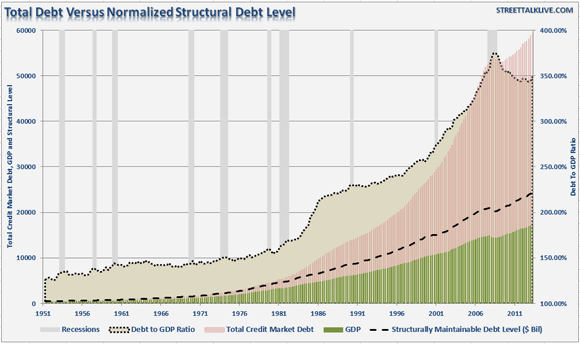U.S. Debt - If We Get Even The Simplest Things Wrong ..
Economics / US Debt Jun 30, 2014 - 10:51 AM GMTBy: Raul_I_Meijer
 If we get even the simplest things wrong, and we do it on a consistent basis, because we lack the tools to look beyond our noses, then what chance do we have of getting the bigger and harder things right? A point I’ve often belabored, and will again a thousand times because it’s the very essence of what we get wrong, is growth, or rather our myopic relationship with it.
If we get even the simplest things wrong, and we do it on a consistent basis, because we lack the tools to look beyond our noses, then what chance do we have of getting the bigger and harder things right? A point I’ve often belabored, and will again a thousand times because it’s the very essence of what we get wrong, is growth, or rather our myopic relationship with it.
There’s not a single school of economics, be it classical, neoclassical, Keynesian or all the others, that even wants to discuss why we need growth, they all take it as a given that we do. Still, what we truly need is a discussion on growth, not growth itself. Because it’s the blind quest for it that is at the root of much of our troubles, not that some of us may or may not have the wrong way we go about achieving it.
There’s nothing special or peculiar, let alone wrong, about the fact that a system, any system, may at some point reach the boundaries to its growth potential. And by flatly denying that these boundaries are even possible at all, we not only risk doing enormous damage to our economies, societies and natural world, we guarantee and lock in that damage. A system that has reached the boundaries to its growth potential tends to self destruct looking for additional but elusive growth.
Again, nothing special. And certainly something we can understand. Except when it’s applied to our own economies. A curious quality of ours.
We see, but we don’t recognize, that tendency towards self destruction today in the various ways we for instance heap additional debt on existing debt like there’s no tomorrow, or in our willingness to dig and drill and inject toxins into our planet just to find a few more drops of fossils to fuel our faltering economic machine. We see the tendency as well as in our attitudes about these things. But we don’t recognize that either.
The illusion that fossils with very low energy efficiencies compared to what we once had can still fuel the same kind of economy and the same kind of growth in that economy, is eerily similar to the illusion that debt can get us out of debt. The only way to sustain such illusions is to have a religious certainty that growth will and must appear at some point. But it mustn’t, and the way things are going, it won’t.
Which might well be fine, if only we would stop chasing it. What are the chances of that, though? If you were a betting man, what would you put your money on, us accepting that we have hit the boundaries of our system, or us going down in flames trying to beat those boundaries? Looks like we’ll never get to talk about how we could use that much touted intelligence of ours to find ways to deal with accepting our boundaries, because we lack the smarts to accept them.
These days, it’s striking to see how this works when it comes to all the new debt and liabilities we load upon our shoulders with, and the way we go about it. More credit growth is seen and presented as a positive thing only, the more the merrier. The choice of words is remarkably void of even an inch of critical thought. Like in this Business Insider piece:
Credit Growth Continues To Boom
The best economic data can sometimes surface when the market isn’t looking. The weekly H.8 report from the Federal Reserve, which shows the assets and liabilities of commercial banks in the U.S., is released at 4:15 on Friday afternoon. And this week’s report looks pretty good. The most recent report showed that commercial bank loans and leases in bank credit continue to surge, and are now up more than 5% year-over-year. Next week is jam-packed with headline economic data, and all of these data are important for gauging the health of the economy. Credit growth, however, is the way you really find out how things are going out there. And it looks pretty good.
Or this from Bloomberg:
Bond Buyers Love That Companies Are Borrowing More Than Ever (Bloomberg)
Companies are on a borrowing binge that’s only accelerating, with investment-grade bond sales poised for a new record year. No one seems to be too concerned because leverage levels – debt to a measure of profitability – are in check, and central banks across the globe are working hard to keep suppressing borrowing costs. Companies have sold $668.4 billion of high-grade notes in the U.S. this year, 11% more than the same period last year and on pace for the biggest annual volume ever, according to data compiled by Bloomberg. Monsanto, the world’s largest seed company, is one of the latest to complete its biggest-ever bond deal, selling $4.5 billion of notes yesterday to help fund a share buyback. Buyers still can’t get enough.
The more people and companies borrow, the better it is. That’s how you “gauge the health of the economy”, is the idea.
But isn’t it true that a healthy economy makes money, instead of borrowing it? And that if it does borrow, it uses the money to produce products, not just paper value? I think it is. And if that is true, we’re in darn deep doodoo. Because the marginal utility of our debt, the amount of debt needed to produce $1 of real value, has fallen through the floor of a bottomless basement, and it will take a thorough and complete revision of everything we do, and all the models we use to do it, to ever find it back.
We know that because of what graphs like these from Lance Roberts at STA tell us. First, the difference between growth and debt has led to a huge deficit:

Which means that ever more dollars in debt are needed to produce one dollar of GDP:

And that in turn means we have a structural, not an incidental, problem:

“Sustainable” debt is “at best” about $25 trillion, and I personally find that a very high level to label “sustainable”. Our actual debt level, however, is $60 trillion. So we will need to shave off at least $35 trillion, or twice yearly GDP, to get back to an economy that could be called functioning and/or productive. Or as Roberts put it:
The Great American Economic Growth Myth
… the economic prosperity of the last 30 years has been a fantasy. [..] The only way to maintain the “standard of living” that American’s were told they “deserved,” was to utilize ever increasing levels of debt. The now deregulated financial institutions were only too happy to provide that “credit” as it was a financial windfall of mass proportions.
When credit creation can no longer be sustained, the process of clearing the excesses must be completed before the cycle can resume. Only then can resources be reallocated back towards more efficient uses. [..] The clearing process is going to be very substantial. The economy currently requires $2.75 of debt to create $1 of real (inflation adjusted) economic growth. A reversion to a structurally manageable level of debt would require in excess of $35 trillion in debt reduction.
This is not some optional exercise. We can’t avoid it, no matter how smart we – think we – are. Nor can we grow our way out of it. We will have to adapt and adjust. If we don’t, we will end up beating each other’s brains in. Though I guess you can call that a way of adapting as well. But it’s not what most of us would like to do, or have done to us. Still, we continue to scramble for a seat in a musical chairs game with ever less seats available. We scramble for our piece of a growth pie that is an illusion, that exists only in our heads.
We are smart enough to understand that. Are we also smart enough to stop trying? Here’s how 86 year old Hong Kong tycoon Li Ka-shing put it to a student audience in a speech about inequality he called “Sleepless in Hong Kong”:
“Today when you rang the bell of truth, what promise did you make to the future? When dawn breaks, is today the tomorrow you worried about yesterday? Your dedication and undertaking to be the custodian of the future is the best antidote for everyone’s insomnia.”
By Raul Ilargi Meijer
Website: http://theautomaticearth.com (provides unique analysis of economics, finance, politics and social dynamics in the context of Complexity Theory)
Raul Ilargi Meijer Archive |
© 2005-2022 http://www.MarketOracle.co.uk - The Market Oracle is a FREE Daily Financial Markets Analysis & Forecasting online publication.



